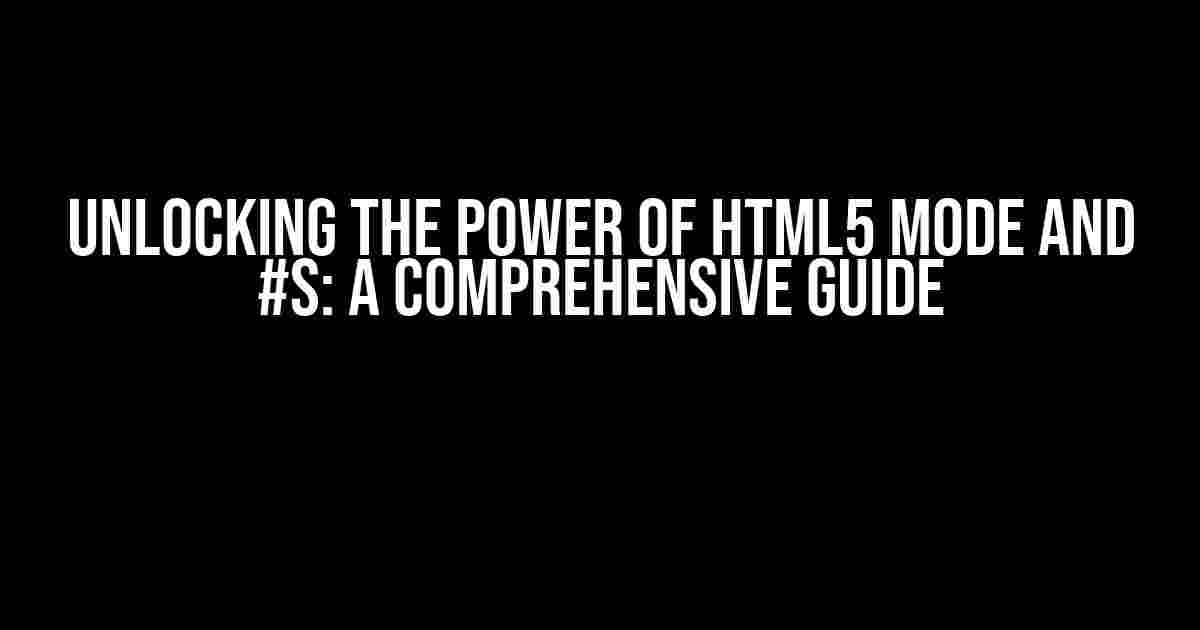Are you tired of dealing with the limitations of traditional URL structures? Do you want to take your web development skills to the next level? Look no further! In this article, we’ll dive into the world of HTML5 mode and #s, exploring what they are, how they work, and most importantly, how you can utilize them to create seamless and efficient web applications.
What is HTML5 Mode?
HTML5 mode is a feature of modern web browsers that allows for a more flexible and efficient way of handling URLs. By default, most browsers use the traditional URL structure, which is based on the fragment identifier (#) and the query string (?). However, this can lead to issues with SEO, bookmarking, and overall user experience.
In HTML5 mode, the browser uses the JavaScript pushState() method to update the URL without reloading the page. This allows for more dynamic and flexible URL structures, making it ideal for single-page applications (SPAs) and complex web interfaces.
How Does HTML5 Mode Work?
The magic happens behind the scenes, where the browser’s JavaScript engine takes care of updating the URL and managing the browser’s history. Here’s a step-by-step breakdown:
window.history.pushState()is called, which updates the URL without reloading the page.- The browser stores the new URL state in its history.
- When the user navigates back or forth using the browser’s back/forward buttons, the browser retrieves the previous URL state from its history.
- The JavaScript engine updates the page content accordingly, without reloading the entire page.
The Role of #s in HTML5 Mode
In HTML5 mode, the # symbol plays a crucial role in defining the URL structure. By default, the # symbol indicates the start of the fragment identifier, which is used to identify a specific part of a web page.
However, in HTML5 mode, the # symbol is used to separate the URL path from the URL parameters. This allows for cleaner and more readable URLs, making it easier for users to share and bookmark pages.
Benefits of Using #s in HTML5 Mode
The use of #s in HTML5 mode offers several benefits, including:
- Improved SEO: Search engines can index and crawl HTML5 mode URLs, improving your website’s visibility and ranking.
- Easy bookmarking: Users can easily bookmark specific pages or states within your web application.
- Enhanced user experience: HTML5 mode URLs provide a more native-like experience, making it easier for users to navigate and interact with your web application.
Implementing HTML5 Mode and #s in Your Web Application
Now that you know the benefits and workings of HTML5 mode and #s, it’s time to put them into practice! Here’s a step-by-step guide to implementing HTML5 mode and #s in your web application:
Step 1: Configure Your Server
Before you can use HTML5 mode, you need to configure your server to handle URL rewriting. This involves setting up URL rewriting rules that redirect incoming requests to the correct URL structure.
RewriteEngine On
RewriteBase /
RewriteCond %{REQUEST_FILENAME} !-f
RewriteCond %{REQUEST_FILENAME} !-d
RewriteRule ^(.*)$ index.html#$1 [L]
Step 2: Update Your JavaScript Code
Next, you need to update your JavaScript code to use the pushState() method and handle URL changes. Here’s an example:
window.addEventListener('popstate', function(event) {
// Handle URL changes here
console.log(event.state);
});
window.history.pushState({}, '', '/new-url');
Step 3: Handle URL Changes
Finally, you need to handle URL changes by updating your page content accordingly. This can be done using JavaScript or a templating engine like Handlebars.
// Update page content based on URL changes
function updatePageContent(url) {
// Get the URL parameters
var params = url.split('#')[1].split('&');
// Update the page content
document.title = params[0];
document.getElementById('content').innerHTML = params[1];
}
Best Practices for Using HTML5 Mode and #s
To get the most out of HTML5 mode and #s, follow these best practices:
| Best Practice | Description |
|---|---|
| Use descriptive URL structures | Use clear and concise URL structures that describe the page content. |
| Avoid over-engineering URL structures | Keep your URL structures simple and easy to maintain. |
| Test and debug thoroughly | Test your HTML5 mode and #s implementation thoroughly to ensure it works as expected. |
| Provide fallbacks for older browsers | Provide fallbacks for older browsers that don’t support HTML5 mode or #s. |
Conclusion
In conclusion, HTML5 mode and #s offer a powerful way to create seamless and efficient web applications. By understanding how they work and implementing them correctly, you can take your web development skills to the next level and provide a better user experience for your users.
Remember to follow best practices, test and debug thoroughly, and provide fallbacks for older browsers. With HTML5 mode and #s, the possibilities are endless – so get creative and unlock the full potential of your web application!
Here is the content:
Frequently Asked Question
Get the inside scoop on HTML5 mode and #s – the ultimate guide to making your web development journey smoother!
What is HTML5 mode and how does it affect my URLs?
HTML5 mode, also known as “html5Mode”, is a feature in AngularJS that allows you to remove the “#” symbol from your URLs, making them looks more like a traditional web page. This mode rewrites your URL using the browser’s history API, which is supported by most modern browsers. When you enable HTML5 mode, AngularJS will use the URL’s path instead of the “#” symbol to route to your application’s states.
How do I enable HTML5 mode in my AngularJS application?
To enable HTML5 mode, you need to configure your AngularJS router to use HTML5 mode. You can do this by adding the `html5Mode(true)` method to your router configuration. Additionally, you’ll need to configure your server to rewrite URLs to your AngularJS application’s root URL.
What are the advantages of using HTML5 mode?
The advantages of using HTML5 mode include better SEO, as search engines can crawl and index your application’s states, and a more traditional URL structure, which can improve user experience. Additionally, HTML5 mode allows for easier bookmarking and linking to specific states in your application.
Are there any limitations to using HTML5 mode?
Yes, there are some limitations to using HTML5 mode. For example, HTML5 mode requires a server that can rewrite URLs to your AngularJS application’s root URL. Additionally, older browsers may not support the browser’s history API, which is required for HTML5 mode to work.
Can I use HTML5 mode with other frameworks or libraries?
While HTML5 mode is an AngularJS-specific feature, other frameworks and libraries, such as React and Ember, offer similar functionality. However, the implementation details may vary depending on the framework or library you’re using.





